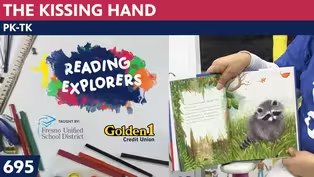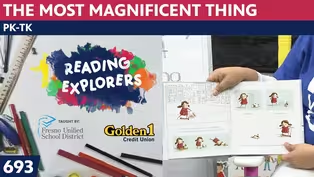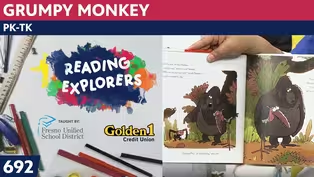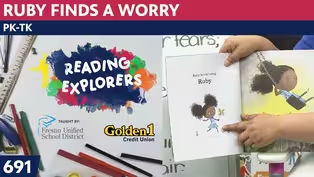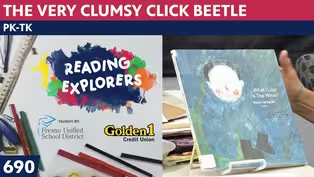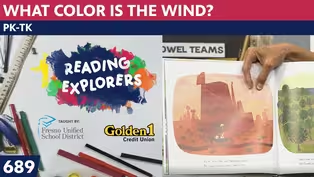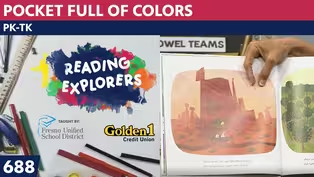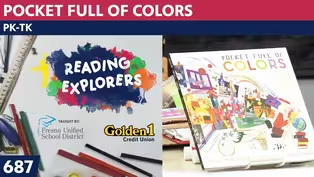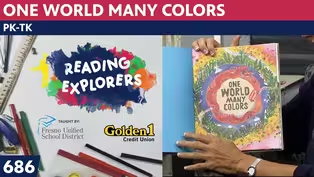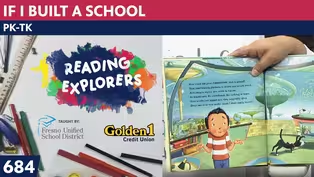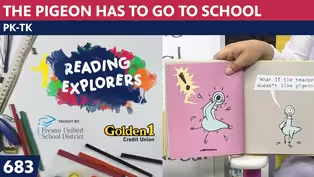
TK-381: John James Audobon & Louis Fuertes
Season 3 Episode 457 | 14m 5sVideo has Closed Captions
Join Mrs. Readwright at Camp Discovery!
Transitional Kindergarten teacher, Mrs. Readwright, welcomes students back to Camp Discovery, a fun learning space packed with reading adventures & fun games!
Problems playing video? | Closed Captioning Feedback
Problems playing video? | Closed Captioning Feedback
Reading Explorers is a local public television program presented by Valley PBS

TK-381: John James Audobon & Louis Fuertes
Season 3 Episode 457 | 14m 5sVideo has Closed Captions
Transitional Kindergarten teacher, Mrs. Readwright, welcomes students back to Camp Discovery, a fun learning space packed with reading adventures & fun games!
Problems playing video? | Closed Captioning Feedback
How to Watch Reading Explorers
Reading Explorers is available to stream on pbs.org and the free PBS App, available on iPhone, Apple TV, Android TV, Android smartphones, Amazon Fire TV, Amazon Fire Tablet, Roku, Samsung Smart TV, and Vizio.
Providing Support for PBS.org
Learn Moreabout PBS online sponsorshipMore from This Collection
Valley PBS and Fresno Unified School District have partnered with Golden 1 Credit Union to create Reading Explorers Lessons for grades Pre-Kindergarten through Third grade. The daily lessons will be taught by Fresno Unified School District teachers and are created to help students practice their reading skills and reinforce lessons during distance learning.
Video has Closed Captions
Valley PBS presents Reading Explorers Lessons for Pre-Kindergarten and TK. (26m 27s)
PK-TK-693-The Most Magnificent Thing
Video has Closed Captions
Valley PBS presents Reading Explorers Lessons for Pre-Kindergarten and TK. (26m 26s)
Video has Closed Captions
Valley PBS presents Reading Explorers Lessons for Pre-Kindergarten and TK. (26m 28s)
Video has Closed Captions
Valley PBS presents Reading Explorers Lessons for Pre-Kindergarten and TK. (26m 28s)
PK-TK-690: The Very Clumsy Click Beetle
Video has Closed Captions
Valley PBS presents Reading Explorers Lessons for Pre-Kindergarten and TK. (26m 22s)
PK-TK-689: What Color is the Wind?
Video has Closed Captions
Valley PBS presents Reading Explorers Lessons for Pre-Kindergarten and TK. (26m 21s)
PK-TK-688: Pocket Full of Colors
Video has Closed Captions
Valley PBS presents Reading Explorers Lessons for Pre-Kindergarten and TK. (25m 58s)
PK-TK-687: Dancing Through Fields of Colors
Video has Closed Captions
Valley PBS presents Reading Explorers Lessons for Pre-Kindergarten and TK. (26m 20s)
PK-TK-686: One World Many Colors
Video has Closed Captions
Valley PBS presents Reading Explorers Lessons for Pre-Kindergarten and TK. (27m 13s)
PK-TK-685: School is Wherever I am
Video has Closed Captions
Valley PBS presents Reading Explorers Lessons for Pre-Kindergarten and TK. (26m 32s)
PK-TK-684: If I Built a School
Video has Closed Captions
Valley PBS presents Reading Explorers Lessons for Pre-Kindergarten and TK. (26m 21s)
PK-TK-683: The Pigeon Has to Go to School
Video has Closed Captions
Valley PBS presents Reading Explorers Lessons for Pre-Kindergarten and TK. (26m 22s)
Providing Support for PBS.org
Learn Moreabout PBS online sponsorship♪ Good morning to a brand new day ♪ ♪ Time to learn and games to play ♪ ♪ Learning things is so much fun ♪ ♪ Learning is good for everyone ♪ (soft music) - Hello early learners, and welcome back to the art room.
I hope you had a great weekend, I did.
And the weather was beautiful.
I was out on the bike trail and I heard the singing of my favorite bird.
And I'll be playing the sound for you in a little bit.
Instead of singing the hello song today, I want you just to think it because we have a lot to do 'cause it is Mystery Monday.
So let's think about what do you think when I show these three things on the suitcase that we're doing today.
This is a bird lamp, and it sits on my kitchen counter, and it is a bird with his mouth open, and the lamp goes in there.
Hm, why would I have that here today?
The second thing I have is this.
And I put it on my fence in the backyard, and in here, seed goes.
Sunflower seeds, bird seeds.
And the final thing I brought comes in this black case.
And in this black case, when you open it up, what do you think is in here?
Let me show you.
I have these on my bicycle because sometimes I see things that I would like to see closer.
So you take off the lens caps and you look through them, and through this, I can see all kinds of birds up close.
So let me put these back and let you know that even though we did Charlie Harper, and here's all the work from last time, we studied birds last week.
Well, those birds were really stylized, which means they were just made of geometric shapes and they didn't look very lifelike.
And I thought we should go through and do a little more art that looks realistic.
Oh my table, I'm knocking it over.
So the realistic birds that we're talking about today are making me want to introduce you to a man who studied birds.
And his name was John James Audubon.
And I have him up here.
When he was a young man, he lived with his family on a farm, and he didn't want to grow up to be a farmer.
And he instead, when he was 12, decided that he wanted to draw birds, and look at birds.
And every time he'd come home, the housekeeper at his house said, what have you been doing?
And he said, looking at birds.
And he wanted to know, where do they go at night?
What do they do when it's winter time?
How do they sleep?
Where do they go?
And he wanted to watch them and find out.
Well, he started drawing birds just so that he would know one bird from another.
Now his father was in the army and his father wanted him to become an army man.
So he sent him to military school.
And when he was 12 and living away from home, he decided he did not want to be in the army.
So at 18, his father sent him to the United States and said, go ahead and go study there, and he did.
And he lived on a farm that they had there, but he didn't work as a farmer.
He looked at birds and went to art school and was drawing birds, and made that his life's work.
And he was the first person to put a little metal band around a bird's leg to see if that bird would return in the winter time.
So he did some really great science things.
Now, I have this book that tells so much about him.
It's called "The Boy Who Drew Birds."
And you can get this from the library, there are several copies there.
Or I bought mine from the children's bookstore in town because they helped me so much.
The other bird book that I want to tell you about is also the other person we're going to talk a little bit about this week.
And his name is Luis Fuertes.
And Luis, this book is about him.
It's called "The Sky Painter."
And he was known as a bird artist.
So that's how these two got to come together to our week of studying birds, because they both were artists who drew birds.
Oh my little stand, I'll just put it down here for now.
But I wanted you to know something else.
In those days, they used to kill the birds and stuff them, so that you could look at them up close.
They didn't have cameras they could use to keep track.
And birds move so quickly.
If you start to draw them, they're off and going.
You start to draw them again, off and going.
So what would happen?
He would like use his memory and think about what the bird shape is like.
So I'm going to show you the steps that he took to draw a bird, because we're going to do this chubby little bird that a child drew and colored.
First they drew it with a pencil, and you can see how chubby this little sparrows body is.
But it started out as an oval, with a round circle squished on top and they kind of cut the round circle into an oval.
Eventually put on the beak, put on the tail feathers, and the feet that have the claws on them to hold onto branches.
So what we're going to do is start the drawing.
I'm doing it with a pencil.
I'm going to outline it with either crayons or pastels so that when we color it, this coloring part, I'm using my water colors.
You can use crayons if that's what you have or pastels or chalk.
So you decide how you want to color it.
But we'll draw the outline of the black first, and then you can put in different patterns like this.
He has spirals here.
One of the guys in the studio said, Oh look, he's got a little letter S here, check this out.
And so they were looking at all the patterns on it.
So you can do any kind of pattern you would like.
So shall we get started?
Let me put my things aside and get out.
I brought thick crayons and thin crayons, wondering which way I would want to do it.
So let me get up my table.
Put it on top here.
I have these thin crayons, and I might use those for the outline, but maybe not.
Let's see.
You might want to have an eraser handy because where the lines overlap, you won't want it to show.
So I'm going to have out my black crayons and keep these right here, and then I'll go over it with a thicker one.
I wanted to also tell you, I brought food coloring.
You might've seen this kind.
Maybe your family colors frosting with this.
This is also that kind, oh, I'm getting it all over myself.
This is another kind of watercolor, but it's actually cake food coloring and it's a little gel, but it's super bright.
Now this will probably be on here all week long because it stays, and you just mix it in with a little water.
So let me get that off a little bit.
Get my pencil, and show you how I'm going to draw that chubby little bird.
Now I will do a drawing and turn it to you.
So I'm going to make first the oval body.
And remember, we want us to use up the whole space of our paper.
And there's my oval body.
Now, however I want my head to be showing, I'll make the circle, but it overlaps like this.
I made a circle here for the head but I squished it down a bit.
I'm going to pull down our inspiration to show you.
This was a seven-year-old who did this drawing.
So I think that it's easier to just see that first they drew the round circle, the oval, if you want it not to be such a chubby body.
And then the round circle here that gets squished.
Now I'm going to erase this line where my oval and my circle crossed, and then I'll outline it with my black crayon so you can see it a little better.
So here is my, oh maybe I better put the tail on before I move on boys and girls, because then I can erase that too.
I'm going to put its tail, but its tail I'm putting its feathers like this down toward its bottom.
So this bird has the tail feathers straight out.
You can have it standing up because when they hop around, they sometimes have that tail feather as a balance.
So I'll erase this between the tail and the body.
All of the places that cross over, you're going to want to get rid of.
So I'm going to start at its bottom.
Go up, go around its head.
And the head will have a little place where the beak is going to go around and meet the tail.
I'm going to go around the tail feather.
And there's more than one there, so it kind of looks like a long M. There it is.
Now I need to turn it toward myself so I see what kind of beak it is.
Now it is a seed eating bird.
So it's beak doesn't have a hook, it's not super sharp, and I'm going to make it go up like this.
So there is my bird shape, and they have a little nostril that's up toward their head.
I'm going to make a big black eye here so that when I paint or color any kind of patterns on here, I'll be able to see that his eye is being taken care of.
You can put any kind of wing you'd like, that's where their flight feathers are so they're kind of thicker, and they go up.
You can make your wing however you would like, but I'm doing mine like this.
And they often have smaller feathers on this part.
Remember to press kind of hard with your crayon, so that it will repel or make the paint stay off.
I'm going to put his two legs, and oh we learned from Charlie Harper that the bird's legs kind of go at an angle down.
I'll put his one toe back and three toes forward.
One toe back and three toes forward.
Now I'm going to get in and get a few crayons out and start doing this.
So I think I'll use some greens and green blues, and make some designs.
Do you know how I like those spirals?
So if I put some spirals down here, look like its body has spiral feathers.
And I'll put some stripes on the tail.
You decide what kind of pattern you're going to do.
Remember, doesn't need to look like mine.
I'm just going to put some dots next to some stripes on his tail, and I'm moving quickly so that I can show you what it looks like when I start watercoloring it.
I might use some warm colors now so that I can, oh, maybe I'll use my big ones.
I'll do some orange up here.
I'll put some stripes of orange on his body.
I think I'll make some orange go this way on his feathers.
Maybe I'll do a little red on that part.
Some feathery feathers.
Don't feel you have to go quickly like I am, I just want to get to the painting part, so that you'll get an idea of what I'm talking about about the watercolor resist.
And in, in, in, doing lots of different things here, or maybe I'll just do some designs.
Maybe some pink 'cause that will show up good too.
Put something around his eye.
And then I'll use a color different from the color that I used, because you don't want to watercolor over with the same color that you had.
Let me show you.
I mixed up that water color to show you the wash that I would do in the background.
And I'm going to just do a little bit and show you how bright this is.
So I'll go next to the paint and wherever it gets near the bird itself, it will just go off because I put so much color in there.
So that's kind of the background, but let me show you what I would do with my water colors, and do a little wash.
I need a lot of water so that it will not stick to the crayon as much as we think it might.
Boys and girls, all week long, you are going to be bringing the same coloring tools.
And so I won't tell you each day bring this or this or this.
Just bring paper and your coloring tools.
Let's get a little bit of green on this bird, maybe on its tummy, on its back.
And wherever the crayon is, this repels.
All right, I'll continue painting.
So let's say, ♪ Oh it's time to say goodbye to all my friends ♪ ♪ Oh it's time to say goodbye to all my friends ♪ ♪ Oh it's time to say goodbye ♪ ♪ Give a smile and wink your eye ♪ ♪ Oh it's time to say goodbye to all my friends ♪ Boys and girls, thank you for joining me today.
We're going to do more bird art tomorrow.
So come back tomorrow with your coloring tools and paper.
I'll see you then.
Bye bye now.
♪ Good morning to a brand new day ♪ ♪ Time to learn and games to play ♪ ♪ Learning things is so much fun ♪ ♪ Learning is good for everyone ♪
Support for PBS provided by:
Reading Explorers is a local public television program presented by Valley PBS
